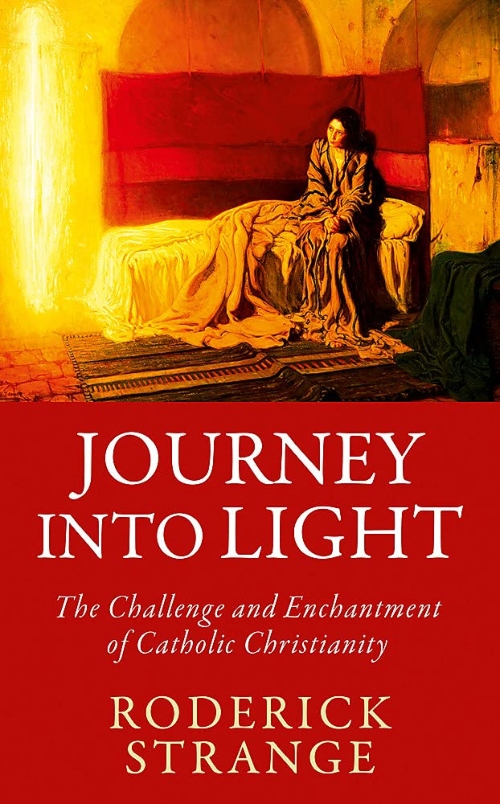Journey into Light by Roderick Strange
Using the liturgical calendar as a roadmap for the journey and peppered with personal recollections and reflections, Strange invites us on a thoughtful, spiritual and open tour of the Catholic faith
 Journey into Light: The challenge and enchantment of Catholic Christianity
Journey into Light: The challenge and enchantment of Catholic Christianity
By Roderick Strange
Hodder & Stoughton
ISBN: 978-1529380002
Reviewed by Terry Young
I enjoyed the Credo in The Times one Saturday during the first lockdown, written by Professor The Right Reverend Monsignor Roderick Strange, so I looked him up. I dropped him an e-mail and Rod responded, noting that he was about halfway through his next book but finding it much harder to make progress with, than he had expected. I offered to look over some of his chapters but (wisely, in response to a cheery and unsolicited e-mail) he did not take me up on the offer. However, when I saw this on The Baptist Times list, I guessed it must be the finished article and wanted a peek.
Curiously enough, this is the second Strange I have reviewed this year (see Making Faith Magnetic by Daniel Strange, 24 June 2022): both are academics but write from very different perspectives.
Rod’s latest contribution is a guided tour through the Church Calendar, written for those unfamiliar with the cycle of Feasts, Fasts and Masses or even the liturgy that guides Roman Catholics through the year. But it’s not simply an introduction to some saints and the days on which they are commemorated, for Rod has decided to come with us on this journey of exploration and share his experiences with us. He recalls friends who said this or went through that door, or simply shared a memorable insight. Because he has lived in Rome and been part of the system, his friends and colleagues are an eclectic bunch, ranging from the highly recognisable to the wholly anonymous.
I was expecting something reflective (which it is) and perhaps a little churchy (which I don’t think it is). Clearly, he refers to many people from circles in which I have never moved but it is not a dominating frame of reference. What I sensed was a good-humoured attempt to explain what his world is like in a warts-and-all sort of way, but without being too defensive. If that was his aim, then I think he succeeds.
What I had hoped for was a peek into Catholic piety and there is certainly an element of that. Rod feels he must justify why as an intelligent and thoughtful person, he can believe in God at all so there is a short oration by way of an explanation before the tour sets off. This felt different to the sort of appeal a Protestant apologist might make, more matter of fact, less worried about whether it will convince the sceptic. While believing you are part of the only true historical church may present a barrier to those of us who trace our lineage in other ways, it does have the remarkable benefit of establishing an even tone.
Rod preserves this tone throughout, even when facing the fact that there are those who have suffered terribly and whose only desire is for the destruction of the churches that bear that brand. For me, this is a strength of the book and enables him to face up to some very challenging episodes in church history.
What I could never quite make out was exactly what Rod believes the Bible is or says in places. Does he, for instance, believe that Lazarus really died in a physically meaningful way? He refers in a slightly curious passage to the ‘widespread tradition about Jesus’ ministry: he brought back to life people who had died.’ (p 97.) At times I wonder if his spiritual view of such scenes is so elevated that the physical details do not matter, while at others I guessed that he wanted to pre-empt the sceptical question in order to get on with sharing his insights. I simply do not know, but I am curious.
There is lots to enjoy in this tour. The quotations from others are plentiful and glorious. Abbot John Chapman, for instance, urges us to, ‘Pray as you can, not as you can’t.’ (p 83.) Rod’s discussion about the emergence of the ‘ministerial priesthood’ is helpful and if you can set aside your sacramental position for a while, one that anyone can learn from (p 104-106). Clearly, we won’t believe (or perhaps unbelieve) all that Rod does but that’s beside the point. He has let us into his world, and the itinerary presents a fine and entrancing spectacle.
Chapter 13, Reforming the Church, is particularly engaging, since he recognises that the Church is still a work in progress. He has a nice way of bringing two contrasting concepts – continuity and radical change – together and sees them as being twin keys to the future.
There are paintings, too, mainly from classical artists although the image on the front cover (duplicated inside), is by Henry Ossawa Tanner, who died less than a century ago. If a hardback edition ever emerges with colour plates, it will be worth your money for the pictures alone and the discussion around each. Having tried something similar last year, I found that sacred art can be a fun way of reflecting on the seasons.
What more I can I say? I’m so pleased to have had the chance to read and review this. Thoughtful, spiritual, open. Read it for yourself.
Terry Young is a missionary kid who read science and engineering. After a PhD in lasers, he worked in R&D before becoming a professor, when he taught project management, information systems and e-business, while leading research in healthcare.
He set up Datchet Consulting to have fun with both faith and work and worshipped at Baptist churches in Slough for 19 years before moving to the New Forest.
Baptist Times, 18/11/2022